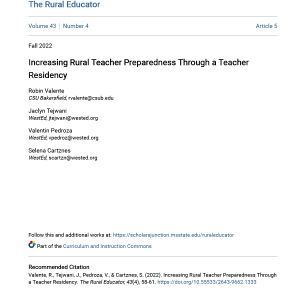Strengthening Rural Education: A California Teacher Residency Success
Posted on

WestEd served as an evaluator of a rural California teacher residency program from 2016 through 2020. This blog post provides an abbreviated version of the researchers’ findings, originally published in Issues in Teachers in Education. The residency model provides valuable lessons learned for education leaders seeking to support teacher preparation, retention, and workforce diversity in rural communities.
Like many rural areas across the country, California’s Central Valley has experienced a pressing need for robust teacher preparation and retention programs. The region sees a high number of novice teachers hired with intern, provisional, or short-term teaching permits or credentials. For example, Central Valley new hires (teachers in their first year) working with an intern credential increased by 35.6 percent since 2017/18, and teachers working with a short-term staffing permit increased by 53.5 percent, according to the California Commission on Teacher Credentialing.
To better prepare and sustain teachers in the region, California State University, Bakersfield and three rural districts partnered in 2015 to design a rural teacher residency program. The 5-year-long program provided participants with extensive coteaching support, mentorship, and access to professional learning communities with their peers. It also included a STEM-focused summer program for residents from partner districts to improve access for students in the Central Valley to STEM learning opportunities.
WestEd conducted an evaluation of the program, gathering data from program leadership and participants and tracking recruitment, hiring, and retention to determine which components of the program succeeded and which could be improved upon.
WestEd, in collaboration with California State University, Bakersfield, found that
- program completers had a 3-year retention rate of 93 percent and a 5-year retention rate of 86 percent, which is higher than the national average for new teachers;
- the program not only contributed to teacher retention but also attracted more diverse candidates than the university’s traditional program;
- program completers consistently rated themselves as more prepared for teaching on most dimensions than the statewide average for the survey items; and
- compared to the statewide average, a higher percentage of program residents felt prepared to teach all content areas and integrate technology.
The focus of the university’s work was on developing a high-quality, sustainable model for rural residency implementation informed by formative and summative data to support program improvement. Once the model was in place and the high-quality program graduates had acquired and retained positions in the partner districts and beyond, word of the residency spread across the Central Valley. This led other districts to explore a partnership with the university, and now five residencies with seven additional district partners are in place, with high-quality educators filling, and remaining in, high-need positions.
The residency model developed by California State University, Bakersfield is an example of how teacher preparation can be adaptive to the needs of a community, cultivate effective and impactful relationships between a university and district partner, and ultimately develop and sustain high-quality educators.
For a more in-depth look at this rural teacher residency program, read Establishing Partnerships in the Central Valley to Expand the Teacher Residency Model, written by WestEd senior research associates Jaclyn Tejwani and Valentin Pedroza, with Robin Valente, professor at California State University, Bakersfield, for the Spring 2023 edition of Issues in Teacher Education.
If you want to learn more about WestEd’s Evaluation Services, please reach out to Jaclyn Tejwani.

